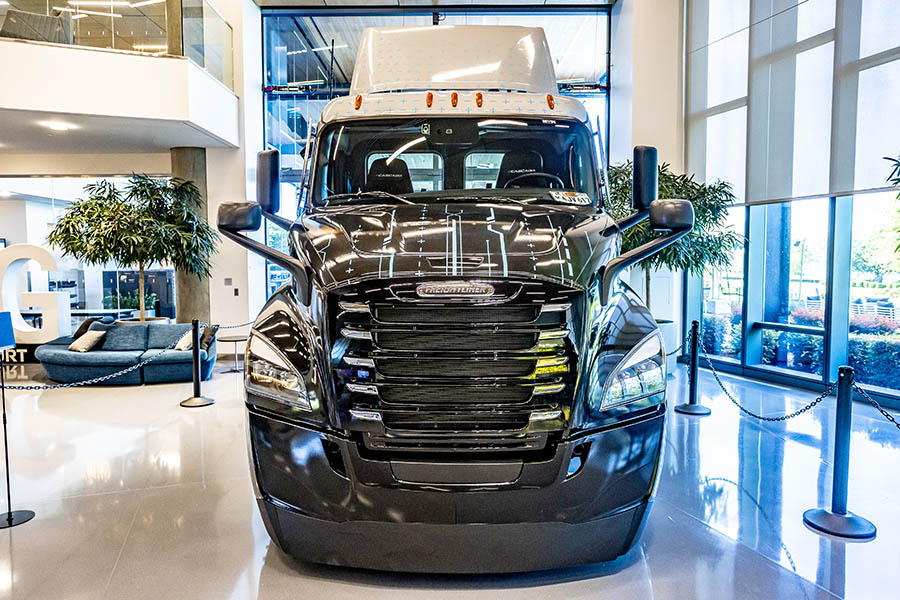Daimler Truck North America unveiled the prototype for an electric Class 8 truck last year to great fanfare and a surge of orders. Now the company is working to speed up charging infrastructure.
At the beginning of 2023, the CEO of Daimler Truck North America acknowledged that sales of its electric truck, the eCascadia, had fallen short of initial expectations.
President and CEO John O’Leary told reporters in January that the company had created the capacity to build 2,000 Class 8 Freightliner eCascadia battery-electric trucks in 2022. The company also had large orders from companies like UPS and Sysco, with the latter announcing in May 2022 that it had ordered up to 800 eCascadia trucks.
“We had in our mind that the market demand was going to be X based on discussions with customers,” O’Leary told reporters in a roundtable at the Manifest supply chain conference, according to the trade publication FreightWaves. “We installed the capacity and then, all of a sudden, [it was] ‘Whoa, wait a minute. I know I told you I wanted 200 in 2023. How about if I take 25 and push the rest out?’”
In other words, customers are pumping the brakes on electric-truck orders — but they haven’t come to a complete stop. O’Leary told the Portland Business Journal that Daimler had dispatched more than 100 trucks from its Swan Island plant by February.
So why the hesitation? The technology for electric freight trucks is here — though there are limitations on what they can be used for. And more importantly, the infrastructure isn’t quite where it needs to be for freight companies to go full-speed ahead on the trucks.
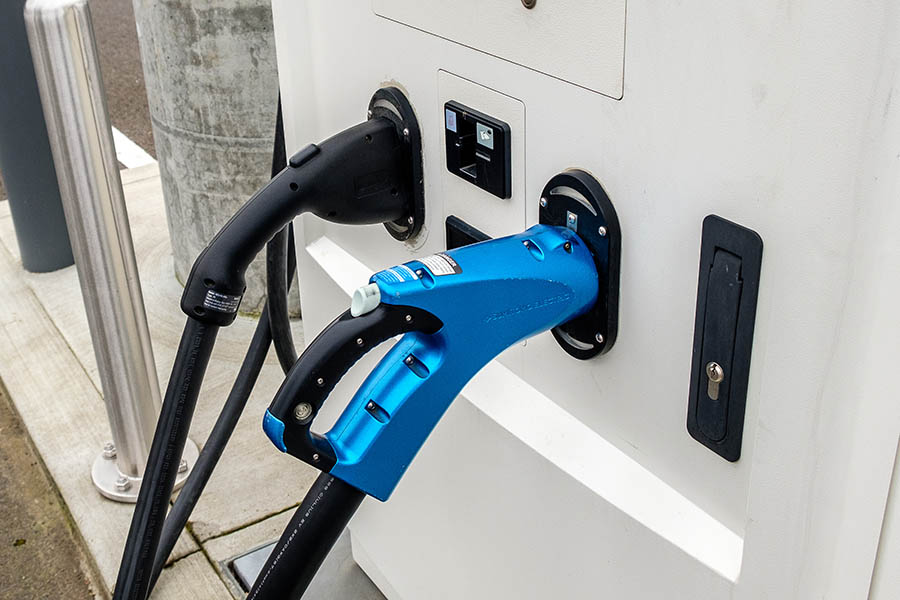
Now the manufacturer is actively researching the latter issue in a partnership with Portland General Electric. And those working in its eMobility division are bullish on the prospects for electric trucks.
Daimler announced plans for the Freightliner eCascadia truck — a battery-operated electric version of the Cascadia trucks the company has produced since 2007 — in 2019. At that time, the company planned to begin line production of the eCascadia by 2021. It missed that mark by a year, slowed in part by the COVID-19 pandemic. But the company unveiled the prototype for the eCascadia in May 2022 at the ACT Expo in Long Beach and began production of the trucks late last year.
Daimler isn’t alone in getting into the electric-truck game. (For clarity’s sake: While the word “truck” refers to many different vehicle types, this article is about Class 8 trucks, often colloquially called semis — the large, heavy trucks used for hauling large quantities of freight.) A handful of other companies have entered the e-truck space, including established semitruck manufacturers like Volvo as well as startups like the Arizona-based Nikola Motor. And electric-car manufacturers are in the game too: California-based BYD, the world’s largest manufacturer of electric vehicles, makes Class 8 and Class 6 trucks as well as refuse trucks. And Tesla began production of a heavy-duty semi earlier this year.
Rakesh Aneja became DTNA’s head of eMobility in 2021. He started his career at Detroit Diesel Corporation — now a subsidiary of Daimler — and spent most of this time there working to improve diesel powertrains.

“Personally, I find purpose in sustainability,” Aneja tells Oregon Business. His work with diesel had a significant sustainability focus — it was all about pollutant reduction and fuel economy — but he describes his shift to focus on electric vehicles as a “180-degree phase change” that necessitated a move from Detroit to Portland.
“Our industry is faced with its biggest transformation ever since its inception,” Aneja says. “And what our company is going through, what our industry is going through, the journey is very similar to what I share it from my own personal story as well.” That is, in the past five to six years, Daimler as a whole has begun to shift its focus to electric mobility, setting a goal to ensure its trucks are carbon-neutral by 2039.
Daimler began working with customers in 2017 in what Aneja describes as a “co-creation” process with 40 different electric-vehicle prototypes being driven by 50 different customers, logging 1.5 million miles and offering feedback along the way.
“You know, in our diesel world, normally we will do customer demonstrations when the product goes to production,” Aneja says. “But here, given the magnitude of the change, we said we’d start much earlier in the development process, involve our customers and really learn together. So this was real-world situations, real drivers, real-world freight — and our joint opportunity to learn together, both how the vehicles are operating and, even more importantly, or at least equally importantly, what is the infrastructure required to operate these vehicles?”
That was what Aneja describes as the “generation one” phase of development. Generation two, he says, is production of the company’s first four series of electric vehicles. In addition to the eCascadia, the company began producing the MT50e commercial van for last-mile delivery in 2020 and Jouley, a Thomas Built electric school bus introduced in 2017. And in May of this year, the company unveiled a Class 6/7 electric truck called the Freightliner eM2. (Class 6/7 trucks are medium-duty commercial trucks, such as beverage trucks.)
Both the eM2 and the eCascadia, Aneja says, are ideally suited for smaller distances where the customer is returning to a home base to charge. One reason is that they can take several hours to charge — as opposed to 15 minutes at the pump for a diesel truck.
And while charging infrastructure for electric vehicles is improving at a rapid clip, it’s still difficult to find charging stations that work well for larger vehicles like Class 8 trucks.
People who are working to electrify the automotive industry — and observers who are bullish on electrification — freely admit there’s a dearth of chargers built to suit larger vehicles.
Ian Hostetler, commercial sales manager for the electric vehicle charging network Electrify America, notes that over the past five years, his company has built a network of 800 stations comprised of more than 3,500 individual chargers — but acknowledges those are for “light-duty vehicles.” The company has opened an Electrify Commercial division to support medium- and heavy-duty use cases.
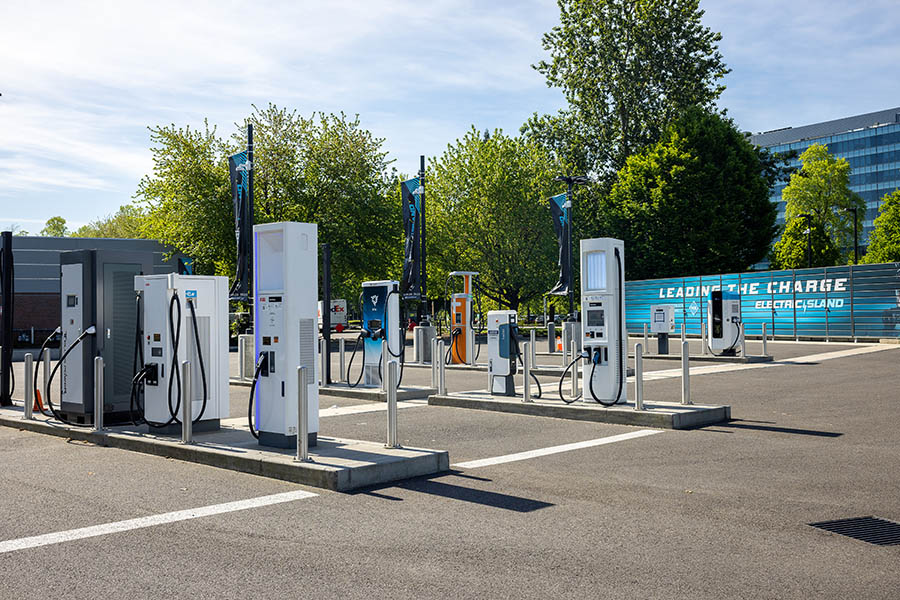
So in 2021, Daimler opened Electric Island, a heavy-duty electric charging site, at its Swan Island facility, in partnership with Portland General Electric. Any member of the public can charge their electric car there, but it’s meant to be a blueprint for the kind of infrastructure larger electric vehicles will need.
“We found that these [heavy-duty] sites can serve the needs of a passenger-car network as well, but not the other way around,” Aneja says. “Our engineers have tried charging Class 8 trucks in a Walmart parking lot, much to the chagrin of Walmart shoppers,” because they take up a lot of parking spaces while charging, and because they charge so slowly.
But Electric Island is primarily being used as a test site for the development of heavy-duty electric vehicles.
Ryan Menze, DTNA’s manager of charger hardware and software engineering, tells Oregon Business the ultimate goal is to develop trucks that can be charged in 30 minutes — the length of a trucker’s legally mandated meal break.
“A driver is required to take a break for 30 minutes over the course of their driving day, so the question becomes, ‘How much charge can we give in that 30-minute window?’ If they’re stopping to unload and they’ve got 15 minutes to chart to plug in, how much range can we get in that 15 minutes?” Menze says.
Menze is optimistic about the near-term availability of charging infrastructure, not just because of the work Daimler is doing to improve the technology but because of policy shifts that will incentivize the necessary buildouts.
The Inflation Reduction Act, passed in August 2022, offers a 6% tax credit for electric charging stations, up to $100,000 per unit. That could be a push in the right direction for short- and medium-term shippers and warehouse sites to set up home-base charging sites for their electric fleets.
And in March of this year, the Oregon Department of Environmental Quality announced it had awarded $13.3 million in grants for medium- and heavy-duty vehicle charging infrastructure. Recipients include Hood River’s Teacup Lake Nordic Club, which will install a charging site for electric snow groomers; an Albertsons warehouse in the Portland area; and a Phillips 66 in Tigard, whose charging station will be open to the public.
The Oregon Department of Transportation has also committed $100 million to improving charging infrastructure in the state, using funds from the National Electric Vehicle Infrastructure Formula program, funded through the 2021 Federal Infrastructure Bill. Matt Noble, ODOT’s public affairs specialist, says the agency is “pursuing every opportunity” for more funding to build out electric infrastructure.
The lack of charging infrastructure isn’t the only thing holding back electric trucks. Another is that they have a short range: The eM2 Class 6 has a range of 180 miles and the Class 7 has a range of 250 miles. The eCascadia has a range of 230 miles before it needs to be charged. Most of Daimler’s competitors in the e-truck space have similar range, with Volvo saying its electric trucks can go 275 without a charge and Tesla publishing estimated ranges of 300 miles or 500 to 600 miles.
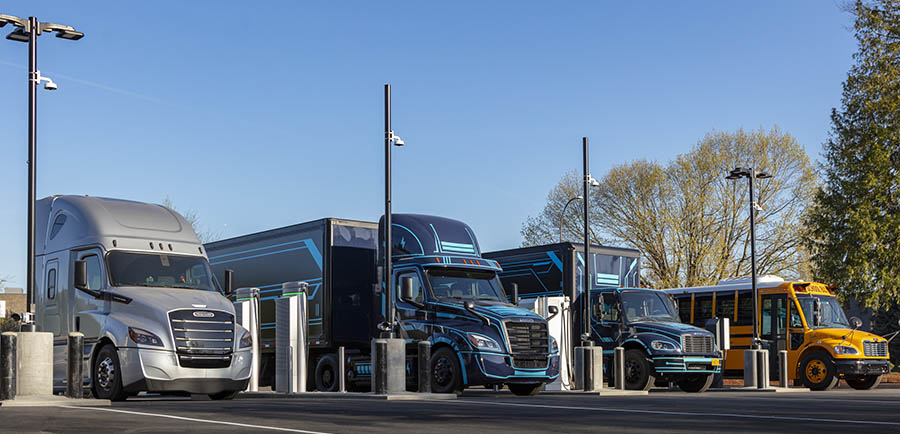
By contrast, a diesel semi can go between 1,000 and 2,000 miles on a single tank. That’s not because they’re particularly fuel-efficient — most get less than 10 miles per gallon — but because the tanks are big, holding anywhere from 120 to 300 gallons of fuel. A tank that size doesn’t fill up as quickly as the trunk of a consumer car, but it doesn’t take hours, either; it typically takes about 15 minutes.
That makes all the available electric trucks impractical for long-haul applications — typically 250 miles per day — notes Jana Jarvis, president of the Oregon Trucking Association.
That’s a point Aneja readily concedes: “We are early in our decarbonization journey, so we don’t have an offering today for long haul, but we are working on it.” His engineers — there are about 200 in the eMobility division — are “working feverishly” to extend the battery range.
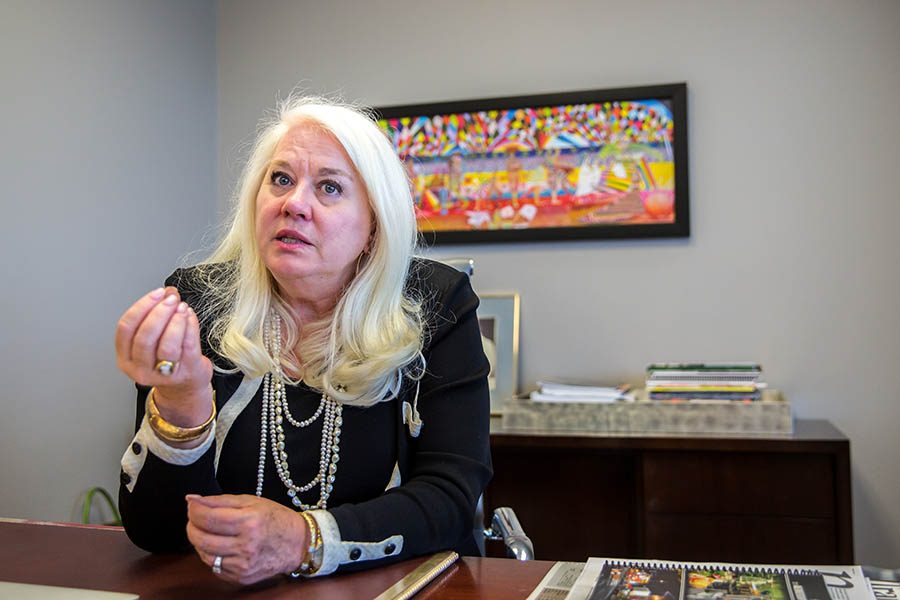
Aneja and Jarvis both expressed optimism about hydrogen-cell batteries, which could be more efficient and offer further range.
Jarvis says she’s heard from members who have purchased electric trucks but are still waiting to install charging stations at their sites. And she notes that Oregon doesn’t have as many opportunities for medium-haul shipping as other states, notably California. She worries that policy changes — like a 2022 California regulation requiring that 100% of new cars and trucks be zero-emission vehicles by 2035, which became a template for an Oregon rule adopted a few months later — are coming ahead of the necessary infrastructure investment.
“It’s a much more complicated conversation than simply moving from diesel to electric,” Jarvis says.
And, she says, the price tag for electric trucks is higher than for diesel vehicles: a new diesel truck costs $130,000 to $150,000, where electric trucks can cost up to $400,000, according to Jarvis.
Aneja did not offer specific numbers when asked about the price point but did acknowledge that the cost of the eCascadia is two to three times higher than a diesel truck.
Menze and Aneja are both hopeful that the cost of ownership can come down — and can be mitigated by lower operating costs, especially as charger technology improves.
“Cost of ownership definitely is a challenge, which partially is our responsibility, and we are working feverishly on that,” Aneja says.
But while Jarvis is skeptical — and understands customers’ reluctance to go all-in on electric trucks — she says they’re a great option for several use cases, if not necessarily a panacea.
“I will be the last person to say that our job is done, because we are only covering a small segment of the applications, right?” Aneja says. “We’re only talking regional pickup and delivery. But for those applications, these are ideal products. They’re very well designed. We have received great feedback from the customers. So at least for that segment of the applications, I feel pretty good about where we are at.”
Click here to subscribe to Oregon Business.

